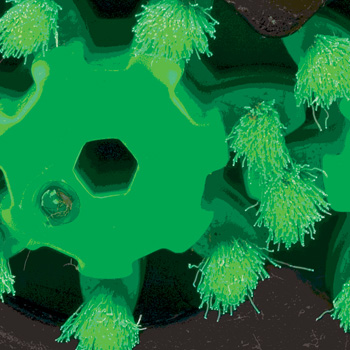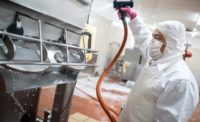Green Housekeeping: Strategies and Sanitation Tools

”It’s not easy being green.
It seems you blend in with so many other ord’nary things.
And people tend to pass you over
‘cause you’re not standing out like
flashy sparkles in the water or stars in the sky.”*
—Kermit the Frog
“Green,” or environmentally friendly, cleaning is is not exactly the easiest subject to tackle. What is often scientifically correct may be politically incorrect when applied to our industry, or any industry for that matter. For as long as I can remember, I always saw a contradiction between citing a restaurant for the inappropriate storage of cleaning chemicals, when the whole place was awash with a caustic cleaner and a Federal Insecticide, Fungicide and Rodenticide Act. (FIFRA)-registered economic poison, aka sanitizer. See? I told you it would be politically incorrect.
Just how large is the cleaning chemical market? Kline & Co. estimated that for the year 2000, cleaning chemicals represent $7.6 billion in annual U.S. sales. Of this total, $2.8 billion is spent by food processing, with an additional $1.4 billion spent by the retail foodservice marketplace. This means that the food industry represents more than half of the total sales of cleaning chemicals in this country. Consider, then, the influence that we as food safety professionals can have by using our sanitation knowledge and buying power and taking extra steps toward applying green cleaning practices and tools in food industry operations.
My quest toward the application of green cleaning in the food industry has been prompted by four primary concerns: employee health, public health, environmental stewardship, and economics. The axiom that “ecology is uneconomic and economics is unecologic” no longer applies. I’ve heard all the excuses, which can be grouped into one sentence: Eco-friendly products do not work and are more expensive. Not so. Several major manufacturers of cleaning chemicals who are quite familiar to us already offer product lines at a competative cost that feature lower toxicity and significantly greater safety. Granted, those facilities that have made the shift to green cleaning also have had to make some modifications to their cleaning methodology, as well as an investment in education and retraining. However, many report that they have had substantially positive results with no economic loss or disruption to production; in fact, cleaning was as good, if not better than using the old products (as a result of retraining) and employee losses were significantly lowered.
To put a little different spin to this argument, consider the following. First, green cleaning is the right thing to do. Our federal government and many state and local governments have already endorsed a national consensus standard for environmentally friendly cleaning products and are including eco-friendly criteria for purchasing in their request for proposals (RFPs). This is also true of several major hotel chains that depend entirely on the aesthetics of presentation. During my career as a sanitarian, I’ve noticed a decided shift in the public’s perception of environmental health, environmental protection and concern for the quality of life. From organic foods that are making inroads into conventional retail food establishments, to smoke-free indoor environments, to wearing natural fiber clothes, consumer demand is significantly changing. Our job has certainly evolved along these societal demands. As this trend continues, I foresee that any company marketing the fact that it supports and uses green cleaning practices and tools will improve its marketshare appreciably in this health-conscious, consumer-driven era of ecologic awareness.
Benefits of Going Green
We know that eco-friendly cleaning helps preserve employee health. Janitorial and cleaning crew complaints of nausea, headaches, eye troubles or skin troubles—often a result of long hours spent spraying and wiping chemicals or performing various housekeeping tasks—ranks quite high with other loss control concerns. To put this risk into perspective, the U.S. Department of Labor ranks hazardous cleaning chemicals among the top hazards of the janitorial industry. Six percent of custodians will be injured by the commercial cleaning products they use this year; 20% of these injuries are serious chemical burns to the eyes and skin. As part of our duties, we sanitarians are quite aware of this phenomenon and often are called upon to make recommendations for changes in cleaning protocols or suggest modifications to sanitation standard operating procedures (SSOPs) in order to minimize cleaning operation-related injuries. Reportedly, the average amount of time lost when a janitor suffers an injury from some form of contact with housekeeping chemicals is 18 hours. Each incident can cost the employer an upward average of $650, which does not necessarily include costs associated with productivity loss and litigation. By conservative estimate, going “green” can save the food industry about $15 million annually due to reduction in medical expenses and lost time wages.
From a regulatory perspective, using green cleaning products can also lower operating costs because managers have fewer toxic chemicals to track and fewer chemical-related injuries to report. Parenthetically, eco-friendly cleaning products are also not as aggressive on the physical plant, particularly production equipment and interior finishes.
We use housekeeping products to make something clean—not to make something caustic, corrosive, contaminated or costly. I see no conflict between the act of cleaning and acts taken to prevent harm to people and to the environment. According to some estimates, more than one-third of the products used today to clean offices, hospitals, stores, restaurants and homes contain ingredients that can have a negative impact on public health and the environment. Some of the harmful ingredients found in these products include carcinogens, endocrine disrupters (which can alter human hormones), reproductive hazards, chemical sensitizers and allergens; skin, eye and respiratory irritants and compounds that are toxic to sensitive aquatic and wildlife ecosystems. The average custodian uses conventional cleaning chemicals that contain 50 pounds of hazardous ingredients annually. Using environmentally preferable cleaning products can yield a 40% reduction in hazardous materials, which is equivalent to about 20 pounds per year per custodian.
The fact is that we all benefit from the use of less chemicals. While the law allows dilution as the solution to pollution, consider the millions of tons of cleaning products that are washed down drains every month. For example, what gets washed down the drain in St. Cloud, Minnesota, will eventually wind up in someone’s dinner in New Orleans, Louisiana. Or, in today’s speedy supply distribution chain, fish that ingested cleaning chemical residues from wastewaters could end up in any number of cities within days.
Similarly, Dr. Alice Ottoboni aptly named her plain-language guide to toxicology The Dose Makes the Poison, a must-read for everyone in the food business. She teaches that there is no such thing as a perfectly harmless (cleaning) compound. However, some are decidedly less toxic than others, so why not opt for the safest one? Looking at a broader picture, it almost becomes George Carlin-esque. Consider the following: We readily use chemicals to sanitize food contact surfaces and utensils that must be compliant with 21 CFR 178.1010; this includes registering these chemicals with the Environmental Protection Agency (EPA) under FIFRA. For all intents and purposes, all sanitizers are lumped in the same class as an economic poison. No argument there: Sanitizers are rightfully regulated in this manner. However, it is also interesting to note that in disposing of these same chemicals (as well as myriad cleaning compounds used by our industry), they have to be listed as a hazardous waste because they do not meet the non-hazard criteria as defined in 40 CFR Part 261. This means that disposal can actually cost considerably more than purchasing the product in the first place. Why? Because of the potential risk of damage it can do to humans and the environment if improperly handled. What a dichotomy: good to use, bad to dispose! But clearly, from a business perspective, something to be seriously considered in a cost-benefit analysis.
How to Be Greener
Currently, there are no formal universally-accepted or consensus-based green cleaning standards and this has caused concern among end-users, government regulatory agencies and manufacturers alike. Federal agencies are facing renewed pressure to adopt so called “green” cleaning practices and purchase environmentally safe cleaning products. But until this is completed, there are some basic purchasing guidelines.
A few years ago, the EPA developed the Environmentally Preferred Purchasing (EPP) program. By Executive Order 13101, the purpose was to guide the purchase of “...products or services that have a lesser or reduced effect on human health and the environment when compared with competing products or services that serve the same purpose.…” The aim was to help purchasers compare the environmental attributes of cleaning products and select those that are environmentally preferable. As a result of this initiative, the U.S. General Services Administration (GSA) developed an extensive catalog that lists many products under the category “Cleaning Equipment, Accessories, Janitorial Supplies, Cleaning Chemicals and Sorbents.” This publication is available from the GSA website.
Even if the GSA catalog is not used to make purchasing decisions, specifications can be modified to include the EPA’s EPP criteria to ensure that the safest and most environmentally preferable housekeeping products are used at your facility. This would still allow locally produced chemicals from small businesses and bidding by local vendors. The criteria that should be added to the bid specifications include the following:
• Biodegradability: All products should comply with the Organization for Economic Cooperation and Development’s definition of ready biodegradability. That is: 60% to 70% biodegradable within 28 days, for each organic component above 1% in the ready-to-use product.
• Non-hazardous Waste: No product should constitute a hazardous waste, as defined in 40 CFR Part 261, when offered for disposal.
• Toxicity: All products must show evidence of low toxicity by demonstrating that the oral lethal dose toxicity (LD50) (rat) is greater than 50 mg/kg;
the inhalation lethal concentration (LD50) (rat) is greater than 2 mg/L; and, that the dermal toxicity (LD50) (rabbit) is greater than 200 mg/kg.
• Environmental Hazard: No product should contain phenolic compounds, petroleum solvents or heavy metals.
In addition to these criteria, the GSA selected six environmental attributes that would be good to consider. While none of the attributes is considered more important than another, it encourages the selection of the most relevant attribute(s) that meet your facility’s needs and balance the available environmental information, along with traditional factors such as price and performance. The following is a brief description of these six “green” attributes:
1. Skin Irritation. Some ready-to-use cleaning products may contain chemicals that can cause skin redness or swelling. If potential skin irritation is a concern, products rated as negligible (none to slight) would be most preferable. If all chemical compounds in the ready-to-use product are less than 5% by weight, there is no inherent risk of skin irritation.
2. Air Pollution Potential. Products may contain volatile organic compounds (VOCs). When these products are used, the VOCs may escape to the indoor environment and cause irritation of the eyes, nose, throat, and lungs and to cause asthma attacks. The labels listing the contents and Material Safety Data Sheets (MSDSs) of the ready-to-use products refer to VOCs as the percent by weight. Ideally, ready-to-use products should contain no VOCs. However, if VOCs are present, the lower the number, the more preferable the product.
3. Fragrances. This attribute does not refer to natural odors that are associated with cleaning agents, such as a lemon odor in a citrus-based cleaner. It refers instead to fragrances that are added to the formulation to improve its odor or to mask offensive odors. While fragrances added to a formulation have little cleaning value, they may provide important aesthetic benefits. Bear in mind that proper cleaning will generally remove the source of most odors, making fragrance additives unnecessary.
4. Dyes. This attribute refers to dyes that have been added to a formulation to enhance or change the color of the product. While the addition of dyes contributes little to the cleaning value of the product, it may be important for safety reasons. These additives may help end-users differentiate between products and other liquids, such as water. Again, a basic principle of pollution prevention is to avoid unnecessary additives. Dyes present for aesthetic reasons only may not be providing a necessary function.
5. Packaging (Reduced/Recovered Content). A product’s packaging can account for a significant portion of the product’s contribution to municipal solid waste. The EPA’s recommended approach to managing solid waste is to reduce packaging of products and to recycle packaging materials. Both attributes should be considered in purchasing any product including housekeeping chemicals.
6. Product Includes Features to Minimize Exposure to Concentrate. Although packaging a product in concentrated form may result in reduced packaging, it raises the potential that the end-users of the product will be exposed to the concentrate. Exposure to the concentrate may place the end-user at greater health risk than exposure to the ready-to-use product. Therefore, the safest approach is to select chemicals where the concentrate is part of a system by which chemicals are transferred only among closed containers. This offers less exposure potential. If this is not possible, choose products where the concentrate is premeasured and prepackaged but not designed to be transferred among closed containers.
Because the information on these attributes is intended only for the purpose of relative comparison, it does not substitute for other guidance on safe product usage. The information on environmental attributes of cleaning agents can help you decide which products to buy but it does not provide guidance on how to use the products. You should continue to carefully follow guidance on MSDSs, labels and other product-specific information to ensure safe usage. Ultimately, by using your existing knowledge of the cleaning requirements of your food operation, working with your cleaning chemical suppliers and educating yourself by reading pertinent guidelines and information such as that offered by GSA, your operation may leap-frog over Kermit and find it very easy—and beneficial—to be green.
Forensic sanitarian Robert W. Powitz, Ph.D., MPH, RS, CFSP, is principal consultant and technical director of Old Saybrook, CT-based R.W. Powitz & Associates, a professional corporation of forensic sanitarians who specialize in environmental and public health litigation support services to law firms, insurance companies, governmental agencies and industry.
Dr. Powitz welcomes reader questions, suggestions for topics and feedback on Sanitarian’s File articles. Contact him directly at sanitarian@juno.com or through his website at www.sanitarian.com.
* From “The Sesame Street Book and Record.” ©1970 Jonico Music, Inc. Lyrics by Joe Rapposo.
Looking for a reprint of this article?
From high-res PDFs to custom plaques, order your copy today!








